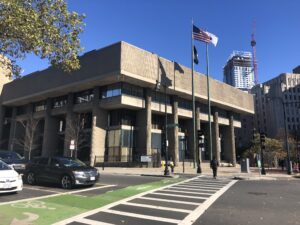State officials say the potential demolition of the historically-protected Charles F. Hurley Building in Boston’s West End is still on the table, a month after publicly indicating the idea was a non-starter because of objections from preservationists.
“Will the building be demolished? The answer is we don’t know the answer until we have a developer and a development proposal selected,” said Abi Valdeck, director of public-private development for the state Division of Capital Asset Management and Maintenance (DCAMM). “We do intend to encourage adaptive reuse and repurposing some or all of the building as part of our RFP process. We will be evaluating proposals based upon how well they do that.”
In November, DCAMM officials said demolition of the Hurley building was unlikely because of objections from preservationists and the need to obtain approval from the Massachusetts Historic Commission.
The state is preparing a request for proposals for redevelopment of the Government Services Center complex, including the Hurley building and a portion of the central courtyard. The Lindemann Mental Health Center at 25 Staniford St., designed by modernist architect Paul Rudolph, and the Edward W. Brooke Courthouse are not part of the redevelopment, although developers would be encouraged to improve the public realm surrounding the two buildings. To enable the improvements, the entire site would be offered as part of the ground lease, Valdeck said during a virtual meeting presentation this month.
The 327,000-square-foot Hurley building houses offices for state labor and workforce agencies including the Department of Unemployment Assistance. DCAMM officials say the private developer would be required to provide 325,000 square feet of office space for lease to state agencies, enabling the consolidation of leases scattered across 25 buildings in downtown Boston.
“If someone comes in with a proposal to provide that space elsewhere in the immediate vicinity, we would entertain that proposal,” Vladeck said.
Approximately 675 state employees who worked in the Hurley building before switching to work from home arrangements during the pandemic will be relocated to alternate spaces in the short term, DCAMM Commissioner Carol Gladstone said.
“We’re going to start the relocation process for those agencies now. The long-term plan is for those agencies to come back to the site,” Gladstone said.
The 1971 building needs approximately $225,000 in maintenance, so the state is looking to private developers to ground-lease the property, which has zoning that allows new buildings with maximum heights of 400 feet.
The draft design guidelines released in November also ask for redesigns that break up the “superblock” between Staniford and New Chardon streets, creating more pedestrian-friendly connections.
DCAMM expects to issue a request for proposals in early 2021, followed by selection of a preferred developer by year’s end and completion of permitting and financing by the developer in 2023.









